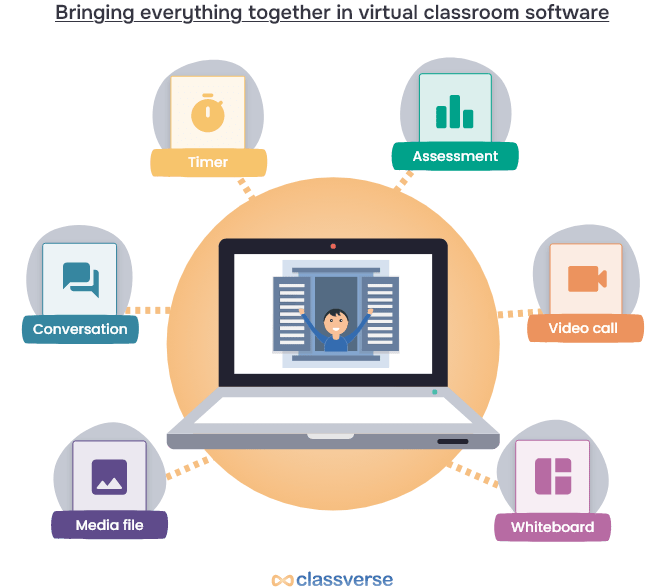Since then, remote learning has become a necessity for every organization, including schools, colleges, universities, and even the corporate world. But many of us are still struggling to understand what it really is and are wasting our time using half-cooked solutions. The truth is that the virtual teaching and eLearning industry is a beast of its own, not to be confused with the real-time communication industry that offers video conferencing, live streaming, and other such services.
In a virtual classroom, the exact number and nature of tools may vary depending on the needs of the instructor or learner. But the goal of all virtual classroom solutions is universal:
Think of all the tools and facilities you use while teaching a class physically – this is everything you need to conduct professional teaching lessons online as well. From the face-to-face communication that happens in a class to the quiz worksheets that a teacher hands out to students for a quick assessment, a virtual classroom must bring everything together and integrate them in a way that enables easier adoption for teachers and students.
Here’s a list of most crucial tools required to teach online:
Virtual classrooms offer teachers the ability to teach students online, which can essentially be done in three ways: synchronously, asynchronously, or in a hybrid setting.
Synchronous learning allows teachers to conduct live classes and interact with students in real-time, similar to a traditional classroom. It provides students with real-time feedback and engagement while enabling teachers to use interactive tools such as chat, breakout rooms, and whiteboards to encourage participation and collaboration.
Synchronous learning occurs in real-time through video conferencing platforms such as Zoom, Google Meet, or Microsoft Teams, while asynchronous learning occurs when students access course materials at their own pace and on their own schedule.
Hybrid virtual classrooms combine both synchronous and asynchronous learning by using a single platform. This means students can access pre-recorded lectures and online course materials at their convenience, while also attending live classes and participating in group activities. Using a hybrid approach provides students with the benefits of both synchronous and asynchronous learning, resulting in a more flexible and effective learning experience.
Choosing the best type of virtual classroom depends on the specific needs of the teacher and students. When choosing a virtual classroom solution, it’s important to look for one that offers features for both synchronous and asynchronous learning, as well as hybrid settings that combine both types of learning for a more flexible and effective approach.
The virtual classroom solution should have built-in video conferencing tools, such as breakout rooms, whiteboards, and chat features, to facilitate synchronous learning and collaboration. Additionally, the solution should offer features that allow students to recap the classes, as well as access pre-recorded sessions, quizzes, course material, etc.
The shift to web-based learning is real. Almost 75% of schools have bought or are planning to buy additional student technology since 2020. Since it is relatively a newer industry, educational institutes are still trying to learn and understand virtual classroom solutions, how to implement them, and what they can offer to their organization.
Classverse – although a new player in the industry – is on a journey to build the next-generation online teaching and learning solution for teachers around the world.
Plus, as a special offer, you can also book an exclusive guided tour of the platform, at no cost. Don’t miss out on the opportunity to revolutionize your online learning experience!



